 Hi, I'm Heidi and I homeschool my two sweet kids. I want them to know that learning is an exciting lifelong adventure! We love great books, unit studies, notebooking, lapbooking, and hands-on learning.
Hi, I'm Heidi and I homeschool my two sweet kids. I want them to know that learning is an exciting lifelong adventure! We love great books, unit studies, notebooking, lapbooking, and hands-on learning.Unit Study: The Science of Snow

Our local public school was on vacation this week. I don’t usually take those weeks completely off, but they are perfect weeks to drop the regular curriculum and enjoy a fun unit study.
Though some of you may be fortunate enough that late February is the end of winter, in Maine spring is still weeks (months!) away. Great timing for a unit study on snow, focusing on the scientific aspects of snowflakes and crystals. After piquing their interest with the microscopic wonder of snowflakes I wanted to teach them about crystals and answer the question: Is it true that no two snowflakes are alike?
Wow! Snowflakes are miraculous!
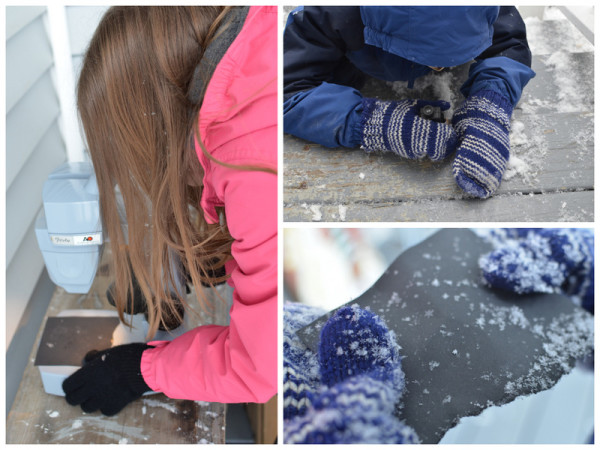
I laid the foundation for their interest a couple weeks ago when I saw large, beautiful flakes falling outside. Grabbing the piece of black paper I’d been keeping in my freezer for just such an occasion, we headed outside with various magnification tools: hand lenses, pocket microscopes, and a stereoscope. I highly recommend this activity whether you go on to study snowflakes or not.

Then this week we kicked off the unit with the picture book Snowflake Bentley about Wilson Bentley, a man who lived in Vermont and spent his life photographing snowflakes to share their beauty with the world.
Homeschool Share offers a free lapbook to go along with this book and is where I found all the minibooks we used. We also perused the thousands of images in Wilson Bentley’s original book, Snow Crystals.
Learning about snowflakes and crystals
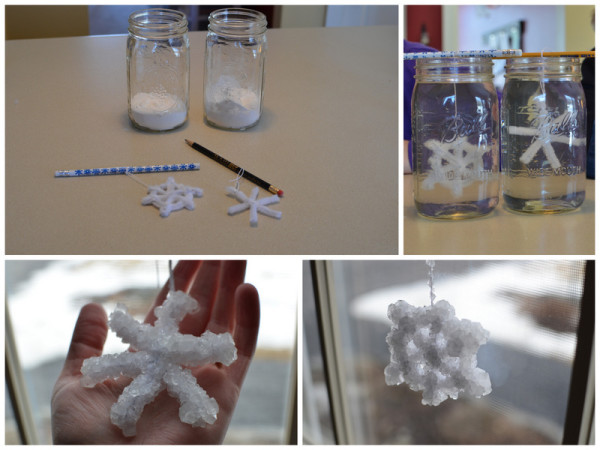
What better way to learn about crystals than to grow them? Making Borax snowflakes gave us the chance to watch crystal formation and drive home the main point: crystals arrange themselves into the patterns dictated by their molecules. While Borax crystals are simple cubes it is the same process that forms the intricate patterns found in each snowflake.
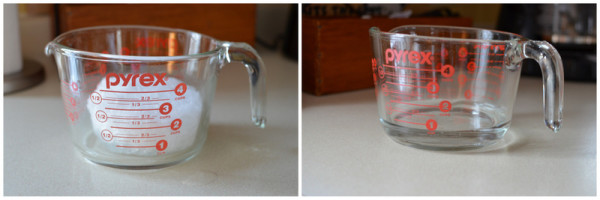
We brought in some snow and made guesses about how much water we would have when it melted. (All of our guesses were too high!) A nice printable from the Homeschool Share unit recorded the information. I used the physical demonstration from Living and Learning at Home to explain the scientific basis for it: we stood near each other with our arms out and realized we couldn’t stand very close to each other. With arms at our side we could pack ourselves in much more closely–just like the water molecules!
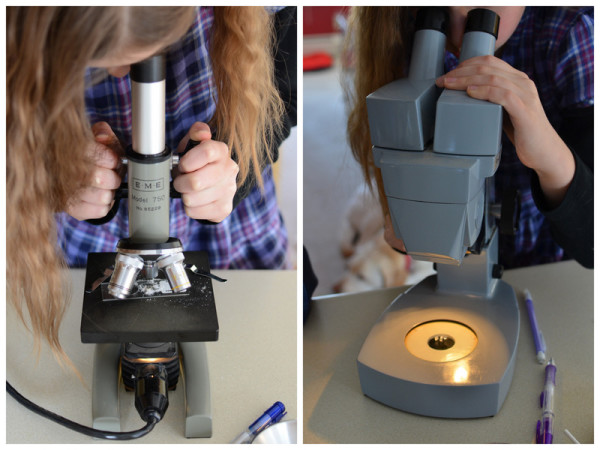
We brought out the microscopes to examine crystals of Borax, salt and sugar. My favorite part about using microscopes is how they increase our wonder at nature: when you see the tiny details you can’t help but be amazed!
Is it true that no two snowflakes are alike?
The book I used to cover the scientific information was The Snowflake: Winter’s Secret Beauty by Kenneth Libbrecht. This book was too advanced to be used as a read aloud, but was perfect for a picture walk. We looked at the images of modern snowflake photography and read the informative captions. This is great video clip about the author:
Once we learned about the factors affecting snow crystal formation, temperature and humidity, it was easy to understand the variety of patterns. As each individual snow crystal moves through different parts of the cloud due to wind and gravity the shapes on the branches tell the history of the conditions it went through. Since no two snowflakes follow exactly the same path to the ground, no two will be truly identical!
The Extras
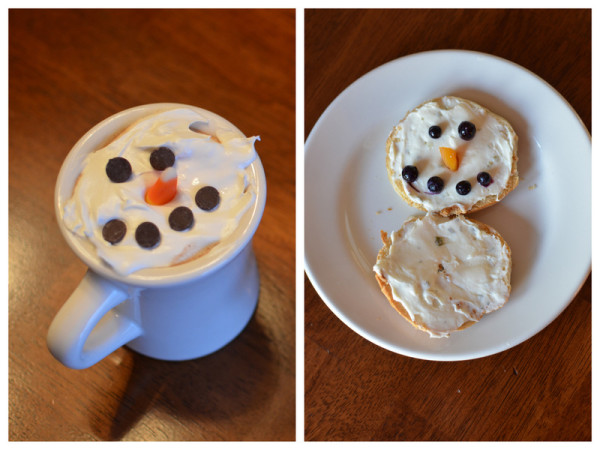
I usually can’t resist a little themed food when we’re studying a topic. Melted snowman cocoa and a snowman bagel fit the bill perfectly. The bagel face is made from blueberries and a piece of dried apricot. (Note: Be sure you have regular cream cheese for the bagel. Don’t be like me and only have chive and onion cream cheese.)
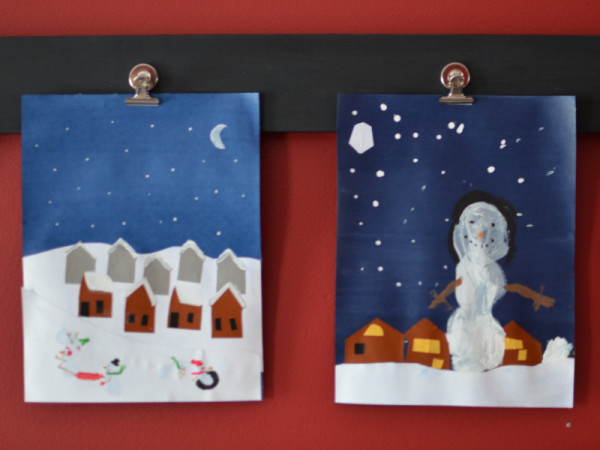
To finish the week we enjoyed a snowman art project from Deep Space Sparkle. She based it on the book Snowmen at Night, a delightful picture book we’ve enjoyed for years.
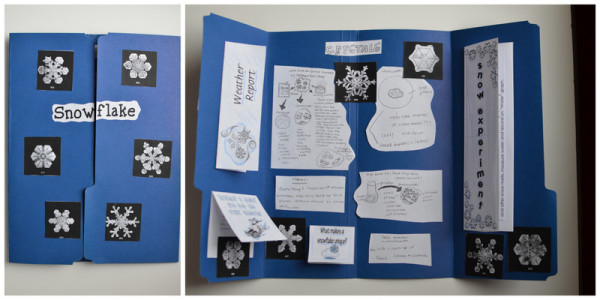
Inside my daughter’s lapbook you can see the minibooks from the Homeschool Share unit and drawings she made when we examined crystals under the microscope.
If you’re still in the throes of winter like me, take a peek at my Winter Activities Pinterest board. You’ll find ideas that are educational, crafty, and just plain fun!
I’m linking up with these great hostesses–join the fun and see what other homeschoolers are doing!
Snow, Celebrations, and Citizen Scientists
Last weekend we caught the end of the big blizzard. The amount of snow wasn’t that unusual for Maine, but the wind made it an extra fierce storm. 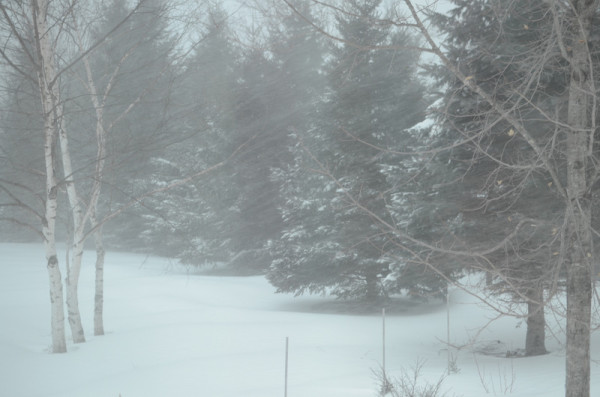
From inside our cozy house we fretted for the birds as they fought their way to and from the feeders. We watched the chickadees aim for one tree but end up blown to another. I was glad for the existing evergreens…and glad I planted over twenty more! After the storm passed this snow mountain was in our driveway and provided hours of building enjoyment.
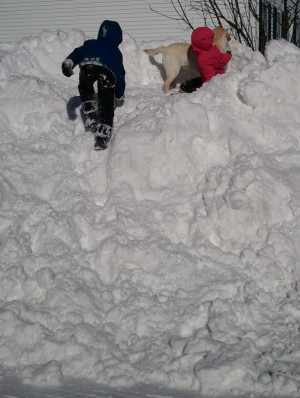
Monday we celebrated our 100th day of school. What a fun day to beat the midwinter blahs! (And yes, in Maine it is really only midwinter…spring is slow reaching us up here.) I detailed all our activities in that post, and would be happy for any new ideas I can put on my list for next year!
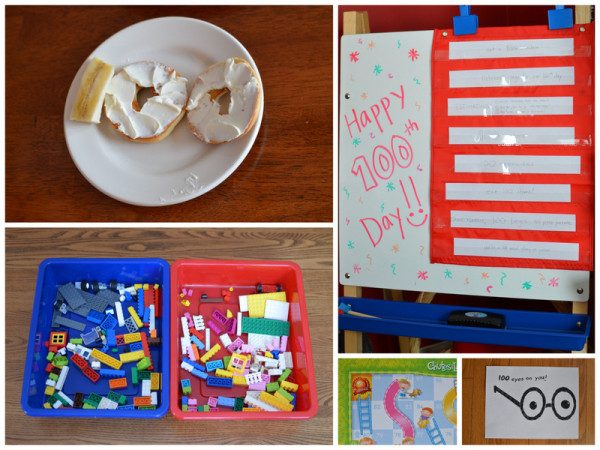
You know how you have those things about school you don’t want your kids to miss out on? Making and exchanging Valentines is one of those for me. Luckily a friend hosted a Valentine Party for about 20 kids and we spent the day crafting, playing games, and exchanging the sweet Valentines our kids had made.

Today we’re donning our citizen scientist hats to participate in the Great Backyard Bird Count. We’ll spend periods of time throughout the weekend with binoculars in hand, tallying what we see for the Cornell Lab of Ornithology to track bird populations. There is still time to participate, just check out the GBBC website!
Thank you to the wonderful hostesses with fun link-ups on Fridays. Be sure to join the fun and see what other homeschoolers are up to!
10 Ways to Celebrate the 100th Day of School
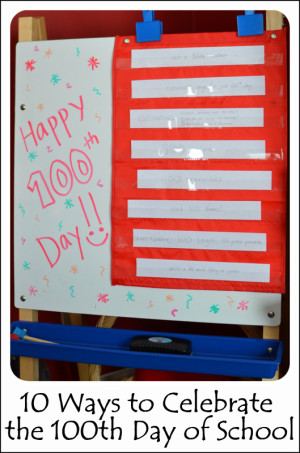
I make our 100th day a time to play with numbers and pat ourselves on the back for being over half way through the school year. It also lands perfectly in the winter doldrums, so it’s an opportunity to ditch the normal schedule and make it a special day.
Here are 10 ways to have a little fun on 100th day:
1. First of all, mark the day! Decorate–just a simple message on the white board, or even break out the balloons and streamers. I personally like making things a surprise, so I didn’t tell the kids ahead of time. They were pretty excited to walk into the schoolroom on a Monday morning to see our whiteboard pictured above. The pocket chart held the list of 100-themed activities we were going to do.
2. I type up a quick and easy list of 100th day questions. I’ve varied the questions, but basically ask about their thoughts on the year so far and then some 100-themed questions. What has been your favorite activity of our school year? What would you buy with $100? I would like to have 100 _______.
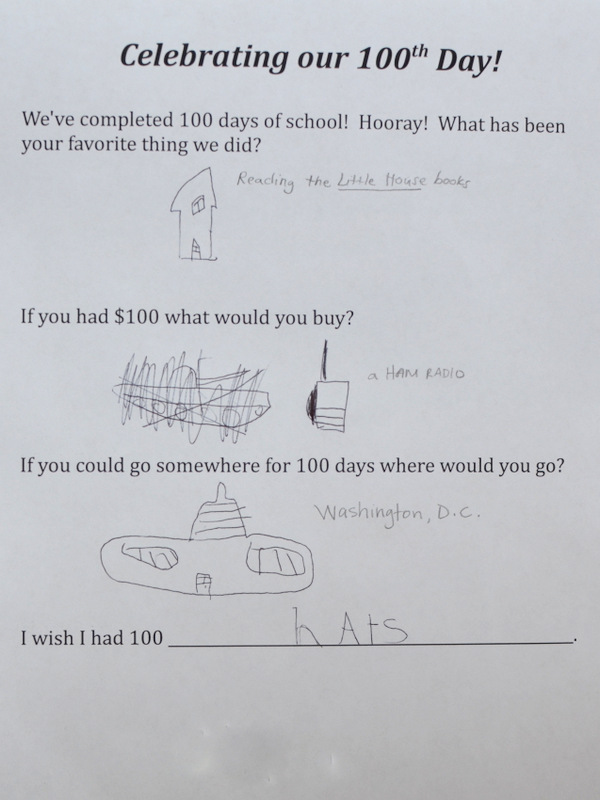
3. To get out the wiggles that can go along with a special day we did 100 exercises! I simply cut five index cards in half and on each half wrote an exercise we would do 10 times, then the kids took turns choosing a card.
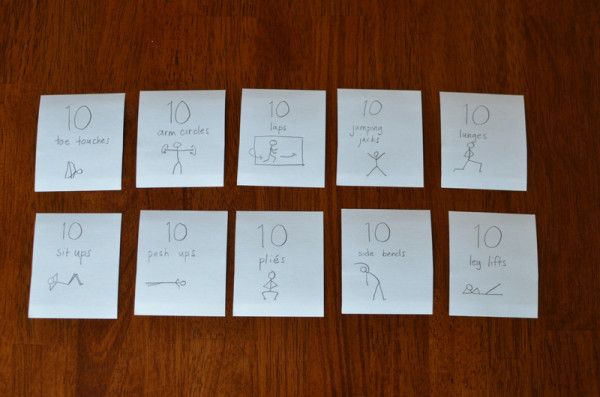
4. Make a picture from the number 100! I gave each of them a big 1-0-0 cut out of paper and instructed them to make them into a picture. My daughter’s finished product really cracked me up!
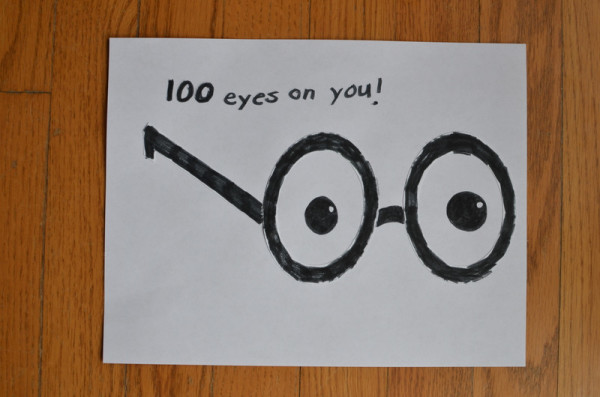
5. We had some fun with estimating. Which container has 100 items? How far will we go in 100 steps? How far can we run in 100 seconds?
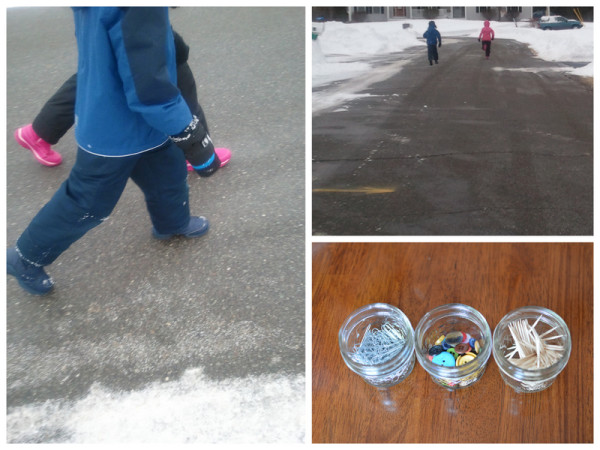
6. Lunch and Breakfast were 100-themed. Breakfast looked like the number 100 and lunch was 100 items!
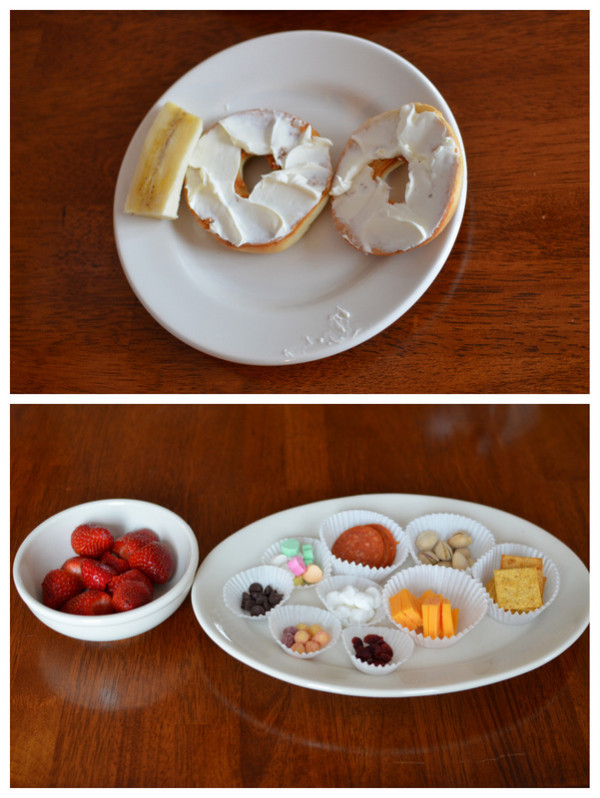
7. Each of them completed a 100-piece puzzle. (I read aloud while they worked–we can’t have a day without reading aloud!)
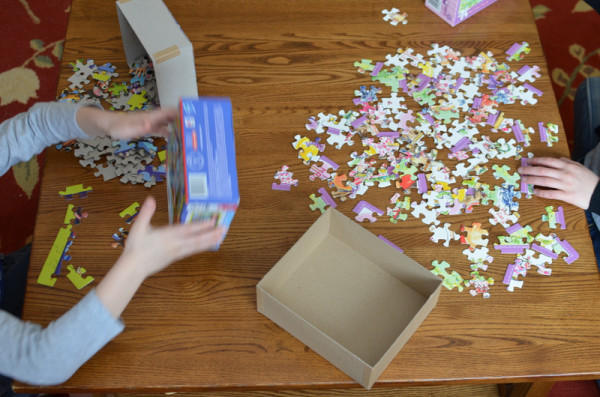
8. We played Chutes and Ladders, since there are 100 spaces!
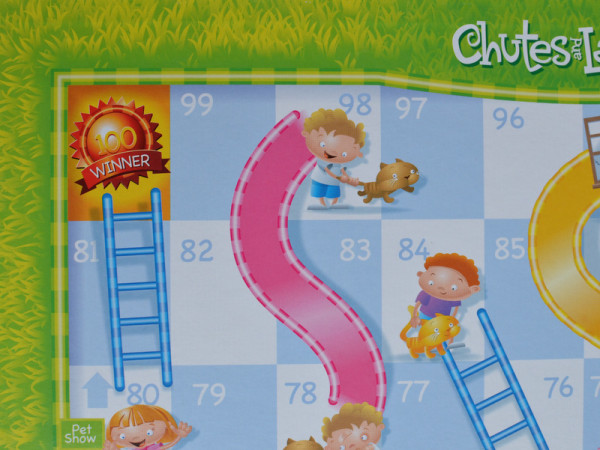
9. The highlight of the day was a Lego Challenge: What can you build with 100 Legos? To add difficulty I chose the 100 Legos and they had to build with just the ones in the tray and use every piece. My daughter built a car (with storage in the back–creative spot for the pieces she didn’t have a place for) and house complete with pool and side play yard for pets. My son’s creation was a factory. He turned his wheels into a conveyer belt!
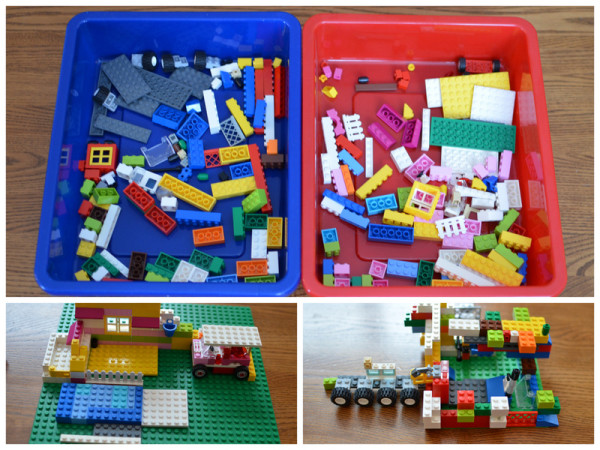
10. Write a 100 word story or poem. We ran out of time before getting to this due to a large mountain of snow outside waiting to be made into a fort. I planned for this to be an optional activity, figuring my 10 year old daughter would be interested but not my 7 year old son. I will add this idea to the list for next year. My daughter writes very long stories, so I think having to choose words carefully and make it shorter would be an interesting challenge.
What ways do you celebrate the 100th day? I’ll need some fresh ideas for next year!
A Collage of Busy Hands
Our week was filled with hands-on activities. I love incorporating busy hands in our schoolwork–activities that reinforce the learning or create useful or beautiful items are always appreciated. And this week nearly every subject had us making and doing.
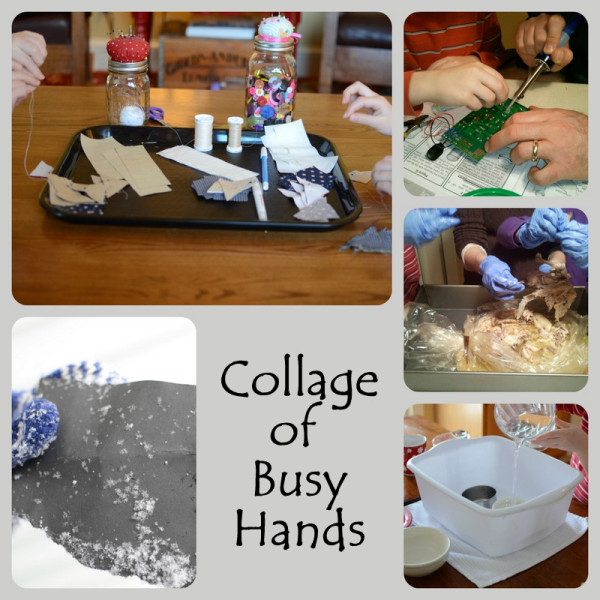
- Sewing a quilt square is a project from our Time Traveler’s unit on the 1800s. I adore doing crafts with my children that become keepsakes and this one fits the bill, along with showing them the work involved in the quilts that pioneer women made. We’re doing all the sewing by hand, just one or two squares at a time as I read aloud. They both enjoy it and are excited to see the pattern coming together.
- My husband and son (both quite electronically inclined and prone to gadget love) built an electronic kit to learn about soldering. This was their first foray into electronics together, they loved it and are working on another kit already. I have put in a request for a robot that cleans the house for me.
- We continued our bird studies by examining a chicken skeleton. Yes, it was our dinner. Yes, my husband gave me an odd look when I said we would bake a chicken for dinner so I could use the bones for schoolwork. Yes, my daughter thought it was gross–but then was fascinated by the experience. I’ll have a full post on our bird unit when we finish.
- More hands-on-math for my son: this time capacity estimation. I’ll also share more on that in a later post–just one note here: have towels handy.
- I’m preparing a snow unit study for a fun midwinter change. We’ll be doing it in two weeks and I had an activity in mind for the unit, but looked out Wednesday to see the perfect snowflakes falling. Reminding myself to be flexible we took advantage and spent time being amazed by nature and the seemingly simple but actually miraculous snowflake.
The neatness of our house suffered quite a bit along the way, but it was a good week. What are your favorite hands-on activities?
Thank you to the wonderful hostesses with fun link-ups on Fridays. Be sure to join the fun and see what other homeschoolers are up to!
Funnix Reading Program Review
My primary goal for my Kindergarten son was to learn to read. As a homeschooler who bases much of our curriculum around quality books, I felt strongly that reading skills are paramount and the best thing I could do to equip him to be a life-long learner. I also knew we would need all the help we could get! Like many boys he is wiggly, silly, and more interested in trucks and Legos than letters and sounds.
You can head over to read my review of the Funnix Reading Program at The Curriculum Choice.
Reboot a Bad Day
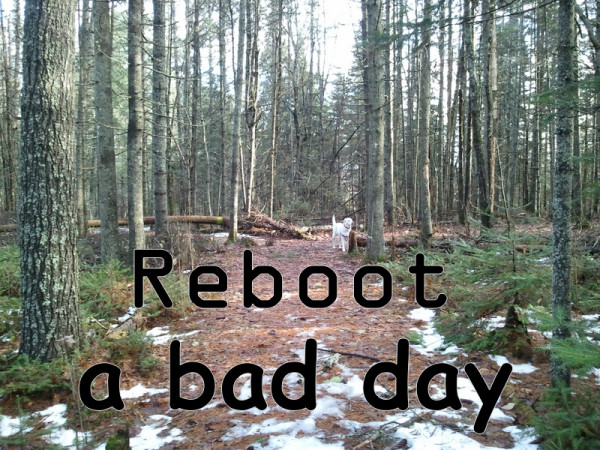
Yesterday was one of those days. Ever have those? It had started out well enough, and I had plans to get a lot of schoolwork done. But it seemed like the more I tried to tackle our list, no matter the subject or activity, the worse it went. By 1:00 we were all irritable and I had already given several stern lectures.
No one was happy, and I dare say no one was learning anything.
My first impulse was to send them up to their rooms and spend an afternoon completely alone…not really productive. There were still hours left until bedtime so I really needed to fix the mood of the day. We needed a reboot–a way to give us a completely fresh start midway through a day.
I told them to get ready, we were heading to the woods. It wasn’t great weather: warmer than usual, but very windy, and instead of sparkling snow there was only mud and dead grass. But I know time in nature is like medicine. I don’t reach for it as often as I should, or I go by myself for time alone, but everyone must go or it isn’t effective. I can return to the house and catch a bad attitude again very quickly.
We walked, ran, explored and laughed at our dog gleefully tromping through every wet spot she could find. We returned from the fresh air renewed and refreshed.
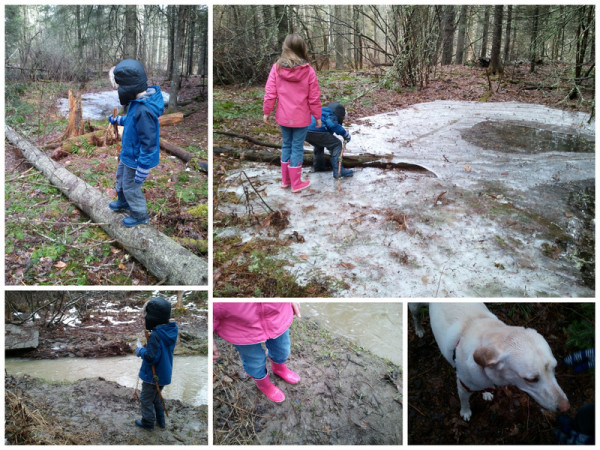
At home we settled in the living room to listen to an audiobook. As always we became caught up in the story and the afternoon passed happily away as our hands busily worked on different things: my son played in sand and built with Legos, my daughter drew, and I cut fabric for a project we’ll be doing together. The day ended happily and productively.
My original plan was not completed, but I’m sure we’ll fit those activities in another day. Better to do them later than to do them and have the reason for doing them lost. I am a list-maker, I love to cross things off my list, and I can also be quite stubborn. Sometimes on bad days I push ahead, forcing my plan on the day. But I am convinced that on those really bad days if I forge ahead no real learning will take place. They won’t remember the information, experiment, or activity if it’s done with a cloud of crankiness over us all.
Try a reboot when you’re having one of those days. You may have many items left on your list, the weather may not be perfect, and you may even need to drive to find a peaceful spot, but you may find it is just what you need to restart the day.
Cold Winter Days Were Made for Reading
The high temperatures in Maine this week have been in the single digits. Brrrrr. We’ve done most of our at-home schoolwork near the gas stove.
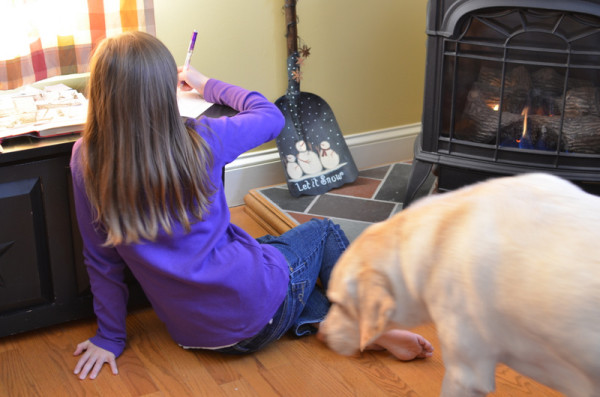
Though we don’t love this kind of weather we remembered to be thankful we live in much more comfort than Laura Ingalls did in The Long Winter.
In our homeschool this week…
- We celebrated Marlin Luther King, Jr. using suggestions from Mary at Homegrown Learners. The Netflix documentary was fabulous and I highly recommend it for all ages.
- Both kids were able to complete their full week of individual work for the first time since before Christmas! Between the holidays and then illnesses we’d had such odd schedules. This week the basics (reading, writing, arithmetic) were done and done well each day. That was a good feeling.
The rest of our learning was all about reading aloud. Quality literature is always our base, and subzero temperatures make for perfect reading time.
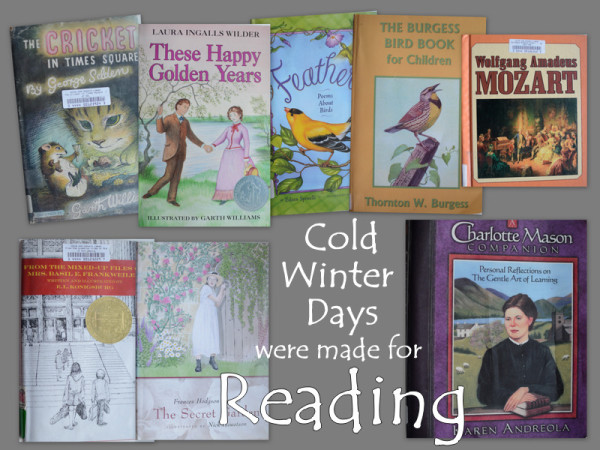
- We read The Cricket in Times Square by George Selden and enjoyed the lovable characters.
- We’re continuing our historical journey with the audio version of These Happy Golden Years. Oh how I love this series and sharing it with my children.
- We continued our nature study of birds despite the frigid temperatures by reading The Burgess Bird Book for Children and continuing to watch the nest cams I talked about last week. It’s amazing to see how fast the hummingbirds are growing! I was able to talk about the “pin feathers” after reading about them in the Handbook of Nature Study. For fun we read through Feathers: Poems about Birds.
- We continued our study of Mozart with the Tell Me About Wolfang Amadeus Mozart Biography and lots of listening. We were all amazed with how young he was when he began not only performing but composing!
- My daughter finished From The Mixed up Files of Mrs. Basil E. Frankweiler and loved it. I asked her to notebook it in some way and she asked to do two book reports–one on the storyline and one on the main characters–and a picture collage. (Oh, okay, if you really must!) She is now reading The Secret Garden and loves that, too. Hooray for great books.
- I am still very slowly working through the original Charlotte Mason series. Did you see the six volume collection for Kindle for 99 cents from Amazon? I picked that up and use it with the Kindle app on my android tablet. I had downloaded the series free from Ambleside but the formatting and table of contents are worth the 99 cents. I also borrowed A Charlotte Mason Companion through inter-library loan. I enjoy Ms. Mason’s writings but also like to have a little help applying it to our homeschool now.
Places we went and people we saw…
Though the cold temperatures made me want to hibernate we had a lot of places to go this week.
- Daddy took the kids on a radio station tour that turned out to not be as technical as my kids were hoping for.
- For my daughter’s book club they attended a talk by author Jennifer Richard Jacobson. It was full of great information about being a writer, and how even as a professional author you have to make lots of revisions.
- Our homeschool geography club meeting was about Russia. My son presented on the volcanoes in Russia and its location on The Ring of Fire. My daughter shared about Matryoshka dolls.
- We paid a visit to the orthodontist. Good news–no one needs braces right now! My pocketbook heaved a sigh of relief.
Things I’m working on…
I’m trying to gather and organize everything to send off to my accountant to prepare our personal and business taxes. Anyone else out there buried in paperwork?
Thank you to the wonderful hostesses with link-ups on Fridays. Be sure to join the fun and see what other homeschoolers are up to!
My Interview for the “Who Homeschools?” Feature
Savannah from Hammock Tracks asked me a few questions for her “Who Home Schools?” interview series. I had fun answering the questions about how and why we homeschool and sharing my goals and concerns.
Stop by Hammock Tracks to check out my interview and find out what my favorite…and least favorite…part of homeschooling is.
A Week Filled With Good Things
This week was filled with easing back into our full time schedule and extracurricular activities after the flu. We made time for afternoon rest and early bedtimes, and continued lots of cozy reading aloud. In fact, this week felt very in tune with Charlotte Mason’s philosophies. I am by no means an expert, but our homeschool does feel full of good things when I implement her methods. We enjoyed good books, poetry, nature study, and composer study.
What books are we enjoying right now?
- We flew through Little Town on the Prairie and feel the impending sadness of the time when Laura’s story won’t be part of our days. My daughter has asked if we can just start again at the beginning.
- American History Stories from Heritage History. (That’s a selection from the Early America CD, which you can receive for free if you purchase any other CD and use the discount code SCHOOLRM until January 31st.) This series is giving my kids (and me!) a good overview of the time period we’re studying while allowing us to spend more time on major events.
- The Burgess Bird Book for Children is part of our nature study focus on birds. The stories are fact-filled and the personalities of each bird we meet keep it engaging.
- We just started The Cricket in Times Square for our homeschool book club…it’s also very engaging so far and leads to cries of “You can’t stop there!”
- I shared poems from A Small Child’s Book of Cozy Poems all week.
Nature study goes to the birds
Our nature study is deepening as we become more and more intrigued by birds. There are three reasons for our increased interest: we’re gearing up for the Great Backyard Bird Count in February, we’ve seen new birds at our feeders, and we’ve been watching nest cams! On these down days requiring a little extra rest we’ve watched this hummingbird nest cam in California and this eagle cam in Florida and been fascinated by the lives of these two (very different) bird families.
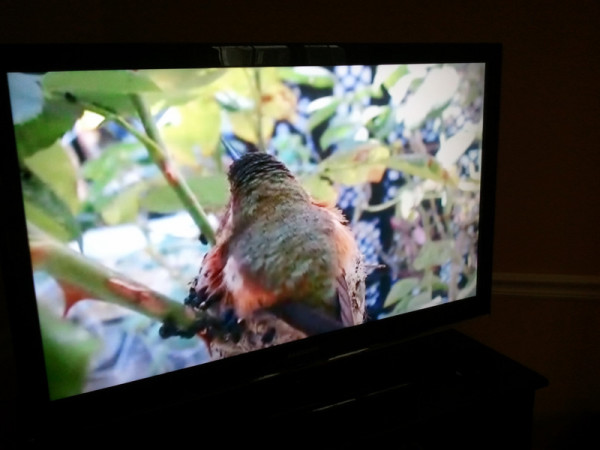
Obviously in nature study the goal is to be out in nature in direct contact with the items you are studying, but these live streaming videos enable us to watch events that would be impossible otherwise. We’ve watched the baby hummingbirds politely excrete wastes over the edge of the nest, how often the momma has to feed those babies and how she does it. We exclaimed as we watched Daddy eagle drop off a fish for his eaglets and their mom. The interest spurred by watching these bird families led to checking out more books at the library!
I had my children pick their favorite from our backyard birds and create a notebook page this week. I love setting them free to notebook as they choose and watching them make the work their own. You can download a free coloring book from Cornell with great line drawings. I like the images but not the questions, so they colored the image, cut it out, and pasted it onto their notebook page of choice. Then they added the details that interested them.
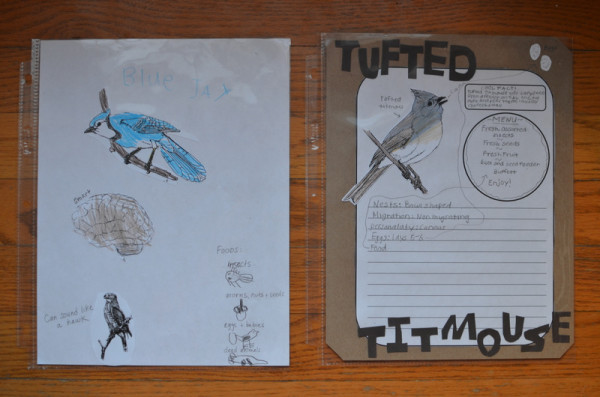
Composer study and our first try at SQUILT
In Harmony Fine Arts our composer of the month is Mozart. We listen to his music during quiet time each day. I’ve been wanting to try the SQUILT technique from Mary at Homegrown Learners and have them really focus on a piece of music. (This post explains the basics of Super Quiet UnInterrupted Listening Time.) She posted a new SQUILT lesson on Mozart yesterday so it was the perfect time to try it.
SQUILT was a great addition to our fine arts studies using HFA! I plan for SQUILT to become a regular part of our week using one of the songs from our composer of the month. Mary’s downloadable SQUILT form was a perfect fit for my ten year old piano-lesson-loving daughter, but I gave my son a sheet of plain paper to draw on.
Mary’s advice on younger or more wiggly children–to allow them to move around during the music and draw on plain paper–was helpful for my seven year old son. If I said “You must sit still and not move and then write words on this paper in these squares” I would turn his happy, open attitude about our classical music studies into dread.
I did learn one thing with our first go-round: my silly son wanted to make faces (albeit to the tempo) to entertain his sister, so we’ll be facing opposite directions or have our eyes closed next time!
And just for fun…
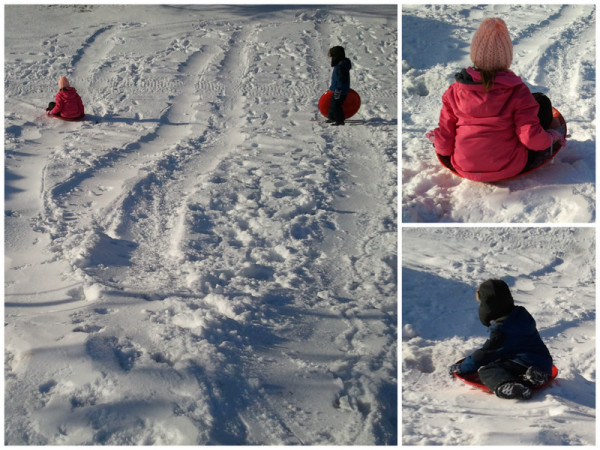
The week ended with a little fun in the snow. I dare an adult to watch a kid flying down a hill on a saucer sled and not join in. I had to jump on a sled and try it out…I laughed the whole way down but I think I’ll have bruises to show for it!
In case you missed it:
I shared a spur-of-the-moment simple hands-on math activity with odd and even numbers. The concept and vocabulary clicked for my seven year old. (You know, that same little boy that made faces during our classical music selection?) He loves (and needs) hands-on learning and asked to play the same odd-even game several times this week.
Thank you to the wonderful hostesses with fun link-ups on Fridays. Be sure to join the fun and see what other homeschoolers are up to!
Hands-On Math: Even and Odd
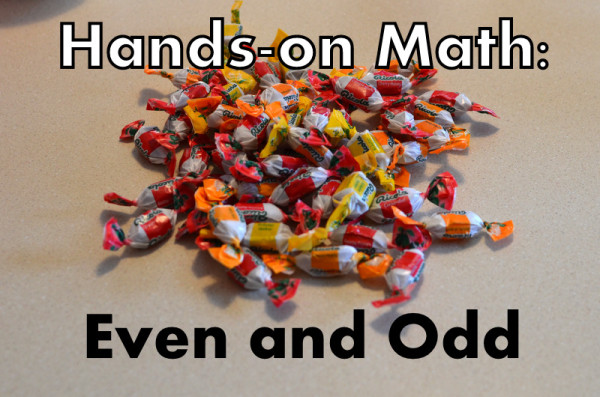
My son understands math best when the teaching is hands-on. I was working on math concepts with him today and trying to explain odd and even numbers. I was using a number chart but didn’t see the light bulb going off. The bowl of cough drops on the counter (can you tell a cold and flu have gone through our house?) caught my eye and I grabbed a handful.
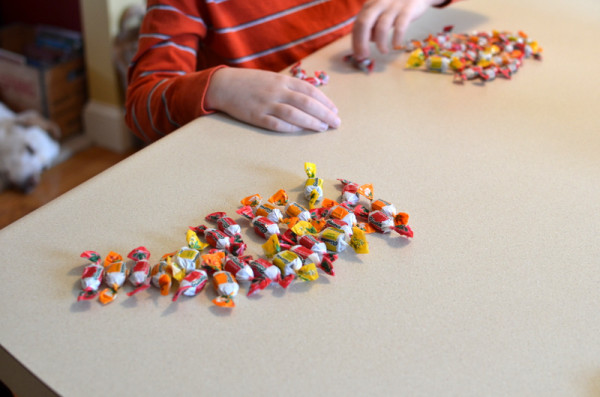
“Let’s divide these between us,” I said. And for each word in silly sentences I made up we each took one cough drop and added it to a pile in front of us.
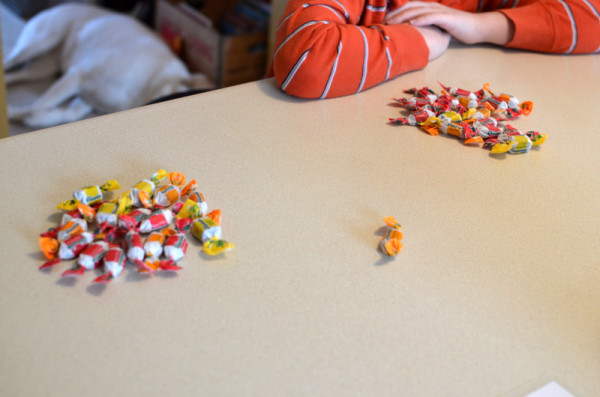
Oh, look! One is left over. We can’t divide it evenly so it’s an odd number!
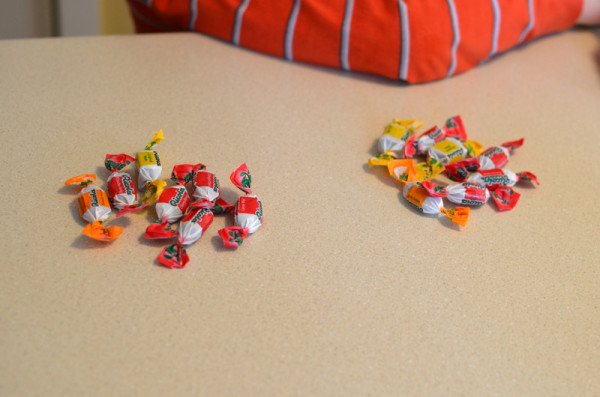
This time we both get the same amount! It can be divided evenly so it is an even number!
It’s ridiculously simple. I’m noticing that even though I tend to look for more complicated procedures first, many things that work are simple (like how he learned coin recognition). The concept and vocabulary clicked in his head, and he thought it was fun and asked to play again and again. We took turns grabbing handfuls of cough drops and guessing if it would be odd or even.
Have you stumbled upon any simple hands-on math teaching strategies I can use with my first grader?







